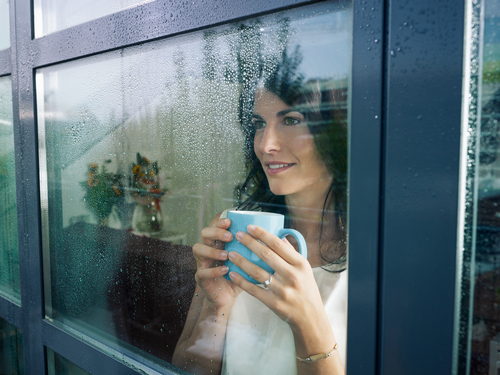
Awnings
By reflecting sunlight up and away from windows, awnings can reduce the overall heat gain of homes. Southern- and western-facing windows benefit especially from this treatment; awnings on these can reduce solar heat gain from 65 to 77 percent.
While awnings generally shade windows and doors, they also can be custom-made to provide cover for the entire side of a house. Depending on your wall insulation, you may see significant reduction in heat gain from a large awning, though you should speak with an expert to learn the most cost-effective approaches for your home and preferences.
Awnings can be made in a variety of materials, each with different maintenance requirements and aesthetic properties. Traditional canvas awnings need to be re-covered every half-decade or so, while modern synthetic awnings are more resistant to moisture and fading. Some homeowners choose to install solar panels as awnings over doors and windows, shading the home and generating electricity at the same time.
Whatever form of awning you choose, you should ensure that it has sufficient ventilation. Hot air can gather under awnings, becoming trapped around the window.
Blinds
Among the most common window treatments and coverings, blinds are effective at keeping heat out during the summer, but are not so effective at keeping heat in during the winter. Blinds can be used for both heat and light control; highly-reflective blinds can reduce solar heat gain by as much as 45 percent, and can also be adjusted to reflect direct light up onto a light-colored ceiling. This can provide diffuse natural light for exterior rooms with windows.
Exterior roller blinds offer a less fine-grained control over your lighting and ventilation, but are simple to install and operate. These blinds can be made of natural wood, but are also found in synthetic materials such as vinyl.
Curtains and Draperies
Draperies come in a wide range of styles and fabrics, which impact their performance as energy-efficient window treatments and coverings. Closing curtains and other draperies during the summer is most effective on windows that receive direct sunlight, though all windows can benefit in winter, when heat may escape through untreated windows.
Light draperies with white (or reflective) plastic backing are most effective at preventing heat gain, while insulated curtains are manufactured to hold heat inside during the winter. Draperies should be hung as close to windows as possible, and can be velcroed or otherwise adhered to the window frame and sill for additional insulating properties.
Reflective films
Mostly recommended for climates with long, hot cooling seasons, reflective films prevent heat gain – but they do so year-round. East- and west-facing windows benefit most from these films, while north windows generally don’t see as much benefit, and south windows should generally be avoided because of the desirability of solar heat gain from the south during the winter.
Reflective films may also be avoided because they reduce the visibility through windows, and the most effective impart a mirror-like sheen when viewed from the outside. However, in specific rooms where additional privacy is welcome or where solar heat gain is a serious concern, they can help keep temperatures manageable.
Shutters
Interior and exterior shutters offer advantages in addition to their insulating properties, including additional window protection against severe weather, additional window security, and a more efficient use of space than many other window treatments and coverings. However, shutters generally impact the architectural integrity of an existing house; they’re much easier to build into a new home construction than to install in an existing space.
How can your home benefit?
Window treatments and coverings are one of many approaches that can be applied in a whole-house approach to energy efficiency. To learn more about keeping your home cool in summer and warm in winter, contact us today at Bryans United Air Conditioning.
Written by Zach Mouton
Image Provided by Shutterstock.com

